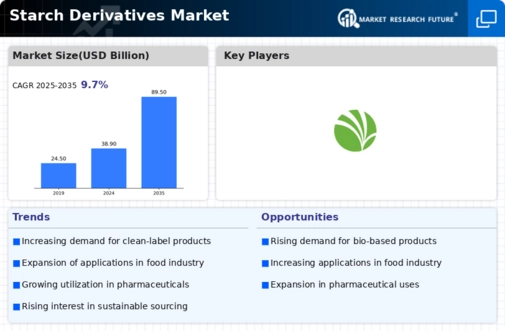-
Executive Summary
-
Scope of the Report
-
Market Definition
-
Scope of the Study
- Research Objectives
- Assumptions &
-
Limitations
-
2.3
-
Market Structure
-
3
-
Market Research Methodology
-
Research Process
-
Secondary Research
-
Primary Research
-
Forecast Model
-
Market Landscape
-
Supply Chain Analysis
- Raw Material Suppliers
- Manufacturers/Producers
- Distributors/Retailers/Wholesalers/E-Commerce
- End Users
-
Porter’s Five
- Bargaining Power of Suppliers
- Threat of Substitutes
- Internal Rivalry
-
Forces Analysis
-
4.2.1
-
Threat of New Entrants
-
4.2.2
-
Bargaining Power of Buyers
-
Market Dynamics of Global Starch Derivatives Market
-
Introduction
-
Drivers
-
Restraints
-
Opportunities
-
Challenges
-
Global Starch Derivatives
-
Market, by Type
-
6.1
-
Introduction
-
6.2
-
Maltodextrin
-
6.2.1
-
Market Estimates & Forecast, 2024–2032
-
6.3
-
Cyclodextrin
-
6.3.1
-
Market Estimates & Forecast, 2024–2032
-
6.4
-
Glucose Syrups
-
6.4.1
-
Market Estimates & Forecast, 2024–2032
-
6.5
-
Hydrolysates
-
6.5.1
-
Market Estimates & Forecast, 2024–2032
-
6.6
-
Others
-
6.6.1
-
Market Estimates & Forecast, 2024–2032
-
7.
-
Market Estimates & Forecast, by Region,
-
Market Estimates & Forecast, by Region,
-
Market Estimates & Forecast, by Region,
-
Market Estimates & Forecast, by Region,
-
Market Estimates & Forecast, by Region,
-
Global Starch Derivatives Market, by Application
-
Introduction
-
Food & Beverages
- Market Estimates & Forecast, 2024–2032
- Market Estimates
- Bakery & Confectionery Products
- Soups, Sauces,
- Market Estimates & Forecast, by Region,
- Market Estimates & Forecast, by Region,
- Market Estimates & Forecast, 2024–2032
- Market Estimates
-
& Forecast, by Region, 2024–2032
-
& Forecast, 2024–2032
-
and Dressings
-
7.2.4.1
-
Market Estimates & Forecast, 2024–2032
-
7.2.5
-
Dairy Products
-
7.2.5.1
-
Market Estimates & Forecast, 2024–2032
-
7.2.6
-
Beverages
-
7.2.6.1
-
Market Estimates & Forecast, 2024–2032
-
7.2.7
-
Others
-
7.2.7.1
-
Market Estimates & Forecast, 2024–2032
-
7.3
-
Personal Care
-
7.3.1
-
Market Estimates & Forecast, 2024–2032
-
7.4
-
Animal Feed
-
7.4.1
-
Market Estimates & Forecast, 2024–2032
-
7.5
-
Pharmaceutical & Nutraceutical
-
& Forecast, by Region, 2024–2032
-
Others
- Market Estimates & Forecast, 2024–2032
- Market Estimates
-
& Forecast, by Region, 2024–2032
-
Global Starch Derivatives Market, by Function
-
Introduction
-
Stabilizing
- Market Estimates
- Market Estimates & Forecast, by Region, 2024–2032
-
& Forecast, 2024–2032
-
Emulsifying
- Market Estimates
- Market Estimates & Forecast, by Region, 2024–2032
-
& Forecast, 2024–2032
-
Binding
- Market Estimates
- Market Estimates & Forecast, by Region, 2024–2032
-
& Forecast, 2024–2032
-
Thickening
- Market Estimates
- Market Estimates & Forecast, by Region, 2024–2032
-
& Forecast, 2024–2032
-
Others
- Market Estimates
- Market Estimates & Forecast, by Region, 2024–2032
-
& Forecast, 2024–2032
-
Global Starch
-
Derivatives Market, by Region
-
Introduction
-
North America
- Market Estimates & Forecast, 2024–2032
- Market Estimates &
- Market Estimates & Forecast, by Application, 2024–2032
- Market Estimates
- US
-
Forecast, by Type, 2024–2032
-
& Forecast, by Function, 2024–2032
-
& Forecast, by Type, 2024–2032
-
9.2.5.4
-
Market Estimates & Forecast, by Function, 2024–2032
-
Forecast, 2024–2032
-
& Forecast, by Application, 2024–2032
-
9.2.7
-
Mexico
-
9.2.7.1
-
Market Estimates & Forecast, 2024–2032
-
9.2.7.3
-
Canada
-
Market Estimates &
-
Market Estimates & Forecast, by Type, 2024–2032
-
Market Estimates
-
Market Estimates & Forecast, by Function,
-
Market Estimates & Forecast, by Type,
-
Market Estimates & Forecast, by Application, 2024–2032
-
Forecast, by Function, 2024–2032
-
& Forecast, by Type, 2024–2032
-
& Forecast, by Function, 2024–2032
-
& Forecast, by Type, 2024–2032
-
9.2.5.4
-
Market Estimates &
-
Europe
- Market Estimates & Forecast, 2024–2032
- Market Estimates
- Market Estimates & Forecast, by Application, 2024–2032
- Market Estimates
- Germany
-
Market Estimates & Forecast, by Function, 2024–2032
-
Forecast, 2024–2032
-
& Forecast, by Application, 2024–2032
-
9.3.7
-
Italy
-
9.3.7.1
-
Market Estimates & Forecast, 2024–2032
-
9.3.7.3
-
France
-
Market Estimates &
-
Market Estimates & Forecast, by Type, 2024–2032
-
Market Estimates
-
Market Estimates & Forecast, by Function,
-
Market Estimates & Forecast, by Type,
-
Market Estimates & Forecast, by Application, 2024–2032
-
Forecast, by Function, 2024–2032
-
& Forecast, by Type, 2024–2032
-
9.3.8.4
-
Market Estimates &
-
Spain
-
Market Estimates & Forecast, 2024–2032
-
Market Estimates
-
Market Estimates & Forecast, by Application,
-
Market Estimates & Forecast, by Function, 2024–2032
-
& Forecast, by Type, 2024–2032
-
9.3.9.4
-
UK
-
Market Estimates & Forecast, 2024–2032
-
Market Estimates
-
Market Estimates & Forecast, by Application,
-
Market Estimates & Forecast, by Function, 2024–2032
-
& Forecast, 2024–2032
-
& Forecast, by Application, 2024–2032
-
9.4
-
Asia-Pacific
-
9.4.1
-
Market Estimates & Forecast, 2024–2032
-
& Forecast, by Application, 2024–2032
-
9.4.5
-
China
-
9.4.5.1
-
Market Estimates & Forecast, 2024–2032
-
9.4.5.3
-
Rest of Europe
-
Market Estimates
-
Market Estimates & Forecast, by Type, 2024–2032
-
Market Estimates
-
Market Estimates & Forecast, by Function,
-
Market Estimates & Forecast, by Type, 2024–2032
-
Market Estimates
-
Market Estimates & Forecast, by Function,
-
Market Estimates & Forecast, by Type,
-
Market Estimates & Forecast, by Application, 2024–2032
-
Forecast, by Function, 2024–2032
-
& Forecast, by Type, 2024–2032
-
9.4.6.4
-
Market Estimates &
-
India
-
Market Estimates & Forecast, 2024–2032
-
Market Estimates
-
Market Estimates & Forecast, by Application,
-
Market Estimates & Forecast, by Function, 2024–2032
-
Forecast, 2024–2032
-
& Forecast, by Application, 2024–2032
-
9.4.8
-
Australia & New Zealand
-
& Forecast, by Type, 2024–2032
-
9.4.8.4
-
Japan
-
Market Estimates &
-
Market Estimates & Forecast, by Type, 2024–2032
-
Market Estimates
-
Market Estimates & Forecast, by Function,
-
Market Estimates & Forecast, 2024–2032
-
Market Estimates
-
Market Estimates & Forecast, by Application,
-
Market Estimates & Forecast, by Function, 2024–2032
-
& Forecast, 2024–2032
-
& Forecast, by Application, 2024–2032
-
9.5
-
Rest of the World (RoW)
-
Forecast, by Type, 2024–2032
-
& Forecast, by Function, 2024–2032
-
& Forecast, by Type, 2024–2032
-
9.5.5.4
-
Rest of Asia-Pacific
-
Market Estimates
-
Market Estimates & Forecast, by Type, 2024–2032
-
Market Estimates
-
Market Estimates & Forecast, by Function,
-
Market Estimates & Forecast, 2024–2032
-
Market Estimates &
-
Market Estimates & Forecast, by Application, 2024–2032
-
Market Estimates
-
South America
-
Market Estimates & Forecast, 2024–2032
-
Market Estimates
-
Market Estimates & Forecast, by Application,
-
Market Estimates & Forecast, by Function, 2024–2032
-
& Forecast, 2024–2032
-
& Forecast, by Application, 2024–2032
-
9.5.7
-
Africa
-
9.5.7.1
-
Market Estimates & Forecast, 2024–2032
-
9.5.7.3
-
The Middle East
-
Market Estimates
-
Market Estimates & Forecast, by Type, 2024–2032
-
Market Estimates
-
Market Estimates & Forecast, by Function,
-
Market Estimates & Forecast, by Type,
-
Market Estimates & Forecast, by Application, 2024–2032
-
Forecast, by Function, 2024–2032
-
Market Estimates &
-
Company Landscape
-
Introduction
-
Market Strategy
-
Key Development Analysis
-
(Expansions/ Mergers and Acquisitions/ Joint Ventures/
-
New Product Developments/ Agreements/ Investments
-
Company Profiles
-
Archer Daniels Midland Company
- Company Overview
- Financial Updates
- Product/Business
- Strategy
- Key Developments
- SWOT Analysis
-
Segment Overview
-
11.1.4
-
Strategy
-
11.1.5
-
Key Developments
-
11.1.6
-
SWOT Analysis
-
11.2
-
Agrana Group
-
11.2.1
-
Company Overview
-
11.2.2
-
Financial Updates
-
11.2.3
-
Product/Business Segment Overview
-
Avebe U.A.
- Company Overview
- Financial Updates
- Product/Business Segment Overview
- Strategy
- Key Developments
- SWOT Analysis
-
Beneo GmbH
- Company Overview
- Financial Updates
- Product/Business
- Strategy
- Key Developments
- SWOT Analysis
-
Segment Overview
-
11.4.4
-
Strategy
-
11.4.5
-
Key Developments
-
11.4.6
-
SWOT Analysis
-
11.5
-
Cargill, Incorporated
-
11.5.1
-
Company Overview
-
11.5.2
-
Financial Updates
-
11.5.3
-
Product/Business Segment Overview
-
Emsland-Stärke GmbH
- Company Overview
- Financial Updates
- Product/Business Segment Overview
- Strategy
- Key Developments
- SWOT Analysis
-
Grain Processing
- Strategy
- Key Developments
- SWOT Analysis
-
Corporation
-
11.7.1
-
Company Overview
-
11.7.2
-
Financial Updates
-
11.7.3
-
Product/Business Segment Overview
-
Ingredion Incorporated
- Company Overview
- Financial Updates
- Product/Business Segment Overview
- Strategy
- Key Developments
- SWOT Analysis
-
Roquette Frères
- Company Overview
- Financial Updates
- Product/Business
- Strategy
- Key Developments
- SWOT Analysis
-
Segment Overview
-
11.9.4
-
Strategy
-
11.9.5
-
Key Developments
-
11.9.6
-
SWOT Analysis
-
11.10
-
Tate & Lyle PLC
-
11.10.1
-
Company Overview
-
11.10.2
-
Financial Updates
-
11.10.3
-
Product/Business Segment Overview
-
Conclusion
-
LIST OF TABLES
-
Global Starch Derivatives Market, by Region,
-
Global Starch Derivatives Market, by Type, 2024–2032
-
(USD Million)
-
Table
-
Global Starch Derivatives Market, by Application, 2024–2032 (USD Million)
-
Global Starch
-
Derivatives Market, by Function, 2024–2032 (USD Million)
-
North America: Starch
-
Derivatives Market, by Country, 2024–2032 (USD Million)
-
North America: Starch
-
Derivatives Market, by Type, 2024–2032 (USD Million)
-
North America: Starch Derivatives Market,
-
by Application, 2024–2032 (USD Million)
-
North America: Starch Derivatives Market,
-
by Function, 2024–2032 (USD Million)
-
US: Starch Derivatives Market, by Type, 2024–2032
-
(USD Million)
-
Table
-
US: Starch Derivatives Market, by Application, 2024–2032 (USD Million)
-
US: Starch Derivatives
-
Market, by Function, 2024–2032 (USD Million)
-
Canada: Starch Derivatives Market, by Type,
-
Canada: Starch Derivatives Market, by Application, 2024–2032
-
(USD Million)
-
Table
-
Canada: Starch Derivatives Market, by Function, 2024–2032 (USD Million)
-
Mexico: Starch
-
Derivatives Market, by Type, 2024–2032 (USD Million)
-
Mexico: Starch Derivatives Market, by Application,
-
Mexico: Starch Derivatives Market, by Function, 2024–2032
-
(USD Million)
-
Table
-
Europe: Starch Derivatives Market, by Country, 2024–2032 (USD Million)
-
Europe: Starch
-
Derivatives Market, by Type, 2024–2032 (USD Million)
-
Europe: Starch Derivatives Market, by Application,
-
Europe: Starch Derivatives Market, by Function, 2024–2032
-
(USD Million)
-
Table
-
Germany: Starch Derivatives Market, by Type, 2024–2032 (USD Million)
-
Germany: Starch
-
Derivatives Market, by Application, 2024–2032 (USD Million)
-
Germany: Starch Derivatives
-
Market, by Function, 2024–2032 (USD Million)
-
France: Starch Derivatives Market, by Type,
-
France: Starch Derivatives Market, by Application, 2024–2032
-
(USD Million)
-
Table
-
France: Starch Derivatives Market, by Function, 2024–2032 (USD Million)
-
Italy: Starch
-
Derivatives Market, by Type, 2024–2032 (USD Million)
-
Italy: Starch Derivatives Market, by Application,
-
Italy: Starch Derivatives Market, by Function, 2024–2032
-
(USD Million)
-
Table
-
Spain: Starch Derivatives Market, by Type, 2024–2032 (USD Million)
-
Spain: Starch
-
Derivatives Market, by Application, 2024–2032 (USD Million)
-
Spain: Starch Derivatives
-
Market, by Function, 2024–2032 (USD Million)
-
UK: Starch Derivatives Market, by Type,
-
UK: Starch Derivatives Market, by Application, 2024–2032
-
(USD Million)
-
Table
-
UK: Starch Derivatives Market, by Function, 2024–2032 (USD Million)
-
Rest of Europe:
-
Starch Derivatives Market, by Type, 2024–2032 (USD Million)
-
Rest of Europe: Starch
-
Derivatives Market, by Application, 2024–2032 (USD Million)
-
Rest of Europe: Starch
-
Derivatives Market, by Function, 2024–2032 (USD Million)
-
Asia-Pacific: Starch
-
Derivatives Market, by Country, 2024–2032 (USD Million)
-
Asia-Pacific: Starch
-
Derivatives Market, by Type, 2024–2032 (USD Million)
-
Asia-Pacific: Starch Derivatives Market,
-
by Application, 2024–2032 (USD Million)
-
Asia-Pacific: Starch Derivatives Market,
-
by Function, 2024–2032 (USD Million)
-
China: Starch Derivatives Market, by Type,
-
China: Starch Derivatives Market, by Application, 2024–2032
-
(USD Million)
-
Table
-
China: Starch Derivatives Market, by Function, 2024–2032 (USD Million)
-
India: Starch
-
Derivatives Market, by Type, 2024–2032 (USD Million)
-
India: Starch Derivatives Market, by Application,
-
India: Starch Derivatives Market, by Function, 2024–2032
-
(USD Million)
-
Table
-
Japan: Starch Derivatives Market, by Type, 2024–2032 (USD Million)
-
Japan: Starch
-
Derivatives Market, by Application, 2024–2032 (USD Million)
-
Japan: Starch Derivatives
-
Market, by Function, 2024–2032 (USD Million)
-
Australia and New Zealand: Starch Derivatives
-
Market, by Type, 2024–2032 (USD Million)
-
Australia and New Zealand: Starch Derivatives
-
Market, by Application, 2024–2032 (USD Million)
-
Australia and New Zealand: Starch Derivatives
-
Market, by Function, 2024–2032 (USD Million)
-
Rest of Asia-Pacific: Starch Derivatives
-
Market, by Type, 2024–2032 (USD Million)
-
Rest of Asia-Pacific: Starch Derivatives
-
Market, by Application, 2024–2032 (USD Million)
-
Rest of Asia-Pacific: Starch Derivatives
-
Market, by Function, 2024–2032 (USD Million)
-
Rest of the World (RoW): Starch Derivatives
-
Market, by Country, 2024–2032 (USD Million)
-
Rest of the World (RoW): Starch Derivatives
-
Market, by Type, 2024–2032 (USD Million)
-
Rest of the World (RoW): Starch Derivatives
-
Market, by Application, 2024–2032 (USD Million)
-
Rest of the World (RoW): Starch Derivatives
-
Market, by Function, 2024–2032 (USD Million)
-
South America: Starch Derivatives Market,
-
by Type, 2024–2032 (USD Million)
-
South America: Starch Derivatives Market, by Application,
-
South America: Starch Derivatives Market, by Function, 2024–2032
-
(USD Million)
-
Table
-
Middle East: Starch Derivatives Market, by Type, 2024–2032 (USD Million)
-
Middle East:
-
Starch Derivatives Market, by Application, 2024–2032 (USD Million)
-
Middle East:
-
Starch Derivatives Market, by Function, 2024–2032 (USD Million)
-
Africa: Starch
-
Derivatives Market, by Type, 2024–2032 (USD Million)
-
Africa: Starch Derivatives Market, by Application,
-
Africa: Starch Derivatives Market, by Function, 2024–2032
-
(USD Million)
-
LIST
-
OF FIGURES
-
FIGURE
-
Global Starch Derivatives Market Segmentation
-
Forecast Research Methodology
-
Five Forces
-
Analysis of Global Starch Derivatives Market
-
Value Chain of Global Starch Derivatives
-
Market
-
FIGURE
-
Share of Global Starch Derivatives Market in 2022, by Country (%)
-
Global Starch Derivatives
-
Market, by Region, 2024–2032,
-
Global Starch Derivatives Market Size, by Type,
-
FIGURE
-
Share of Global Starch Derivatives Market, by Type, 2024–2032 (%)
-
Global Starch
-
Derivatives Market Size, by Application, 2022
-
Share of Global Starch Derivatives Market,
-
by Application, 2024–2032 (%)
-
Global Starch Derivatives Market Size, by Function,
-
FIGURE
-
Share of Global Starch Derivatives Market, by Function, 2024–2032 (%)









Leave a Comment